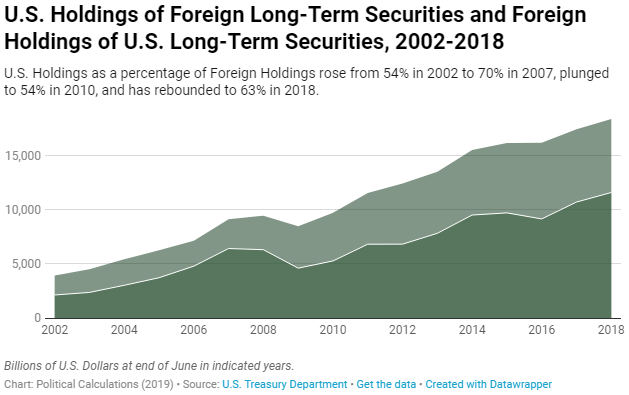Not long ago, we looked at foreign ownership of U.S. stocks, which raised a question from our readers: "How much of the world's stocks do U.S. investors own?"
We don't have a specific answer for that question, because the U.S. Treasury Department groups equities, such as stocks, in with debt having a term-to-maturity of one year or longer into the category of long-term securities in its data on the topic, where the question we can answer is "how much of the world's long-term securities do U.S. investors own?"
In the following interactive graphic, we show the answer recorded at the end of June for each year from 2002 through 2018. [If you're accessing this article on a site that republishes our RSS news feed, please click through to access a fully working version on our site, or click this link to see a static image of that chart.]
In the chart, we've compared apples-to-apples as best we can, showing the values of foreign long-term securities owned by U.S.-based investors against the backdrop of the value of U.S. long-term securities held by foreign interests.
Reviewing the history, we see that U.S. holdings of foreign long-term securities as a percent share of foreign holdings of U.S. long-term securities rose from 54% in 2002 to peak at 70% in 2007 before plunging to a low of 54% in 2010. Through 2018, it has recovered to 63% of the value of foreign-held U.S. long-term securities.
References
U.S. Department of the Treasury and Federal Reserve Bank of New York. Foreign Portfolio Holdings of U.S. Securities, as of June 29, 2018. [PDF Document]. 15 May 2019.
Labels: data visualization, debt, stock market
Welcome to the blogosphere's toolchest! Here, unlike other blogs dedicated to analyzing current events, we create easy-to-use, simple tools to do the math related to them so you can get in on the action too! If you would like to learn more about these tools, or if you would like to contribute ideas to develop for this blog, please e-mail us at:
ironman at politicalcalculations
Thanks in advance!
Closing values for previous trading day.
This site is primarily powered by:
CSS Validation
RSS Site Feed
JavaScript
The tools on this site are built using JavaScript. If you would like to learn more, one of the best free resources on the web is available at W3Schools.com.
